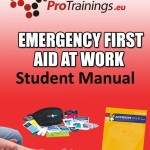 The Emergency First Aid at Work course (EFAW) is ideal for most businesses whose risk assessment has identified that there is no requirement for a fully trained first aider for their workplace. This course is available as a HABC qualification or as a ProTrainings CPD certified qualification, all courses are delivered, evaluated and quality assured to meet the new guidelines set out by the HSE in October 2013 and meet the requirements of the First Aid at Work (First Aid) regulations 1981
The Emergency First Aid at Work course (EFAW) is ideal for most businesses whose risk assessment has identified that there is no requirement for a fully trained first aider for their workplace. This course is available as a HABC qualification or as a ProTrainings CPD certified qualification, all courses are delivered, evaluated and quality assured to meet the new guidelines set out by the HSE in October 2013 and meet the requirements of the First Aid at Work (First Aid) regulations 1981
- level 2 Award in Emergency First Aid in the Workplace (QCF)
- Industry Body for First Aid Training – ProTrainings Emergency First Aid at Work
This course must be at least 6 contact hours and run over a minimum of 1 day and the certificate is valid for 3 years. To renew you need to attend another EFAW 6 hour course. This course must be delivered as a 100% classroom course and cannot be delivered via online or blended training to comply with the HSE requirements. Candidates completing our EFAW courses receive access to our video library for refreshing skills and reference.
The HSE strongly recommend that all first aiders complete an annual first aid refresher courses and our online course meets this requirement.
The content of this and all our courses has been independently certified as conforming to universally accepted Continuous Professional Development (CPD) guidelines and come with a Certified CPD Statement as well as a ProTrainings Certificate and for online courses an Evidence Based Learning statement.
This course gives learners the opportunity to gain a formally recognised QCF qualification. If you require funding, a QCF or SCQF qualification is often required. Phone us and we can advise if needed. If you choose our course leading to a QCF qualification, there are additional assessment criteria to be undertaken with an instructor and a small extra certification charge.
| QCF Qualification Details | |
|---|---|
| Course Title: | Emergency First Aid at Work |
| QAN: | 600/7372/X |
| Level: | 2 |
| Credit Value: | 1 |
| GLH: | 8 |
| The Register of Regulated Qualifications | |
| Funding Information | |
Occupations that can use this course:
- Offices
- Service industries
- Self employed
- Factories
- Manufacturing
- Construction and Building
- Distribution
- Forestry (see also our FAW Forestry course)
- High risk businesses
- Agriculture
- Sports
- Outdoor Pursuits and Exploring
Curriculum:
The following syllabus meets the HSE requirements laid down for course content as follows:
- Initial Care
- First Aid at Work Regulations and Rules
- Fears of First Aid
- Barriers
- Initial Assessment
- Unconscious Breathing and Recovery Position
- Cardiac Problems
- The Heart, Sudden Cardiac Arrest, Heart Attacks and CPR
- One Rescuer CPR
- Chest Only Compressions
- CPR Handover to a Second Rescuer
- Other Primary Care First Aid Problems
- Adult Choking, Conscious and Unconscious
- Serious Bleeding Management and Wounds
- Shock
- Spinal Injury Management
- Burns and Scalds
- Anaphylactic Shock and Allergies
- Seizures and Epilepsy
Learning Outcomes and Assessment Criteria for our EFAW Course
1 Understand the role and responsibilities of an emergency first aider
1.1 Identify the role and responsibilities of an emergency first aider
1.2 Describe how to minimise the risk of infection to self and others
1.3 Describe how to complete an incident report form
1.4 Identify the first aid equipment available and describe how it can be used safely
2 Know how to assess an incident
2.1 Describe how to conduct a scene survey
2.2 Describe how to make a primary survey of a casualty
2.3 Identify when and how to call for help
3 Manage an unresponsive casualty who is breathing normally
3.1 Demonstrate how to assess a casualty’s level of consciousness
3.2 Demonstrate how to open a casualty’s airway and check breathing
3.3 Demonstrate how to place an unconscious casualty into the recovery position that maintains an open airway and explain why it is important
3.4 Describe how to treat a casualty who is in seizure
4 Manage an unresponsive casualty who is not breathing normally
4.1 Demonstrate how to administer effective Cardio Pulmonary Resuscitation using a manikin
5 Recognise and assist a casualty who is choking
5.1 Describe how to identify a casualty with a partially and completely blocked airway obstruction
5.2 Demonstrate how to treat a casualty who is choking
6 Manage a casualty who is wounded and bleeding
6.1 Demonstrate how to control severe external bleeding
7 Manage a casualty who is in shock
7.1 Describe signs and symptoms of shock
7.2 Demonstrate how to manage a casualty who is in shock
8 Understand how to manage a casualty with a minor injury
8.1 Describe how to manage a casualty with:
Small cuts, grazes and bruises
Minor burns and scalds
Small splinters





